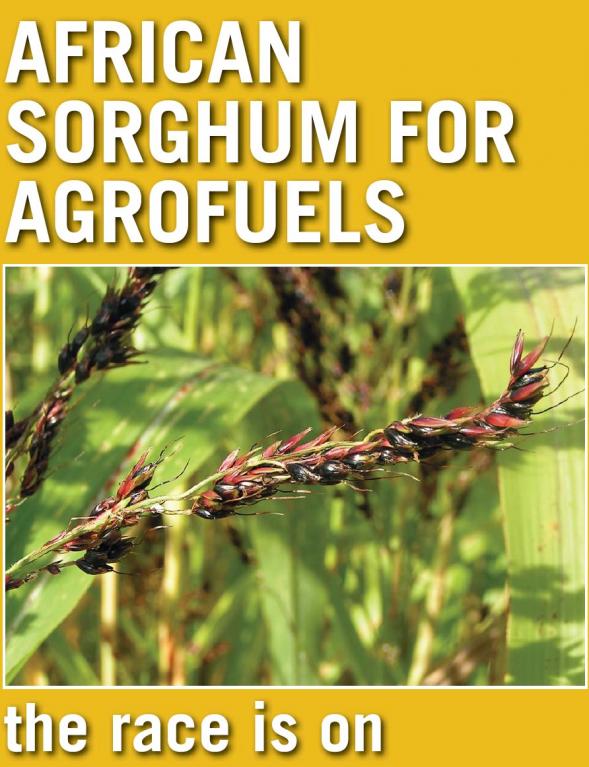Latest Resources

19 February 2011
Agrochemical giant DuPont to sell Bolivian sorghum gene
In 2012 multinational giant DuPont plans to begin selling sorghum varieties containing a valuable gene taken from a sudan grass that was collected in 2006 in Bolivia. The gene, branded as ‘Inzen A II’, makes sorghum plants tolerant to herbicides made by DuPont and other companies, and was acquired under exclusive license from Kansas State […]

16 February 2011
African Millet Under Threat
The African Centre for Biosafety (ACB) has focused several recent reports on new international commercial interest and patent claims on the African native crop sorghum. This includes the issues raised by the proposed widespread use of sorghum for the production of agrofuels. This report extends ACB’s examination of new international commercial interest in African native […]

4 February 2011
Sorghum and the Antioxidant Craze: What Benefit for Africa’s Farmers?
A highly successful health food company in the United States, Silver Plate Inc, is seeking to cash in on the health benefits of sorghum. More particularly, it has begun to commercialize foods rich in sorghum anthocyanins, natural “antioxidant” chemicals found in some strongly coloured plant foods that are believed to have heart and other health […]

31 January 2011
Water Efficient Maize for Africa: Pushing GM Crops onto Africa
This paper looks at the Water Efficient Maize for Africa (WEMA) project within the context of the race by massive agribusiness corporations to bring climate change related crops to the market. The first part of the paper explains the WEMA project within this context, outlining the players and the stakes involved. It looks at who […]

28 October 2010
Synthetic Biology in Africa: Recent Developments
By Gareth Jones and Mariam Mayet The focus of this paper is the emerging field of synthetic biology, in particular its implications for the African continent. Synthetic biology combines a number of scientific disciplines and is generally understood to involve the deliberate design of biological systems, using standardised components that have been created in a […]

27 October 2010
Biosafety Protocol: Ten years on and lagging far behind
Mariam Mayet attended COP MOP 5 in Nagoya Japan. Indeed, she has been following the Biosafety Protocol discussions since 1999. In this brief, she argues that the Biosafety Protocol lags far behind the biosafety challenges faced by developing countries such as South Africa. She also expresses deep disappointment with the loss of a international civil […]

21 July 2010
Who is Biosafety South Africa
In this briefing, we present an overview of a new organisation called Biosafety South Africa. Biosafety South Africa was launched early this year, receives funding from the South African government through the Department of Science and Technology. Biosafety South Africa has no legislative mandate to influence GMO decision-making but appears set to carve its niche […]

14 May 2010
A good neighbour? South Africa forcing GM maize onto African markets and policy makers
Since the beginning of 2010, South Africa’s Executive Council responsible for GMO permit approvals has granted export permits for almost 300,000 Metric Tons (MT) of GM maize to be exported to Kenya, Mozambique, and Swaziland collectively, and 35,000 MT of GM soybean to Mozambique.1 Despite South Africa being Africa’s largest producer of maize, and a […]

12 April 2010
GM Sugarcane: A long way from commercialisation?
Despite the best part of a decade of research and field trials, genetically modified sugar cane in South Africa remains a long way from commercial cultivation. Numerous research projects are currently underway at a number of publicly and privately funded research bodies, most of which are concentrating on increased sucrose and biomass content. Late last […]

12 March 2010
African Sorghum for agrofuels: the race is on
Author: Edward Hammond About the briefing: The interlocking problems of climate change, emissions from fossil fuels, and limited oil reserves have stimulated interest worldwide in the use of plant crops to produce fuel. Agrofuels are not a new idea. Brazil, for instance, has used them on a large scale for many years. The potential scale […]
